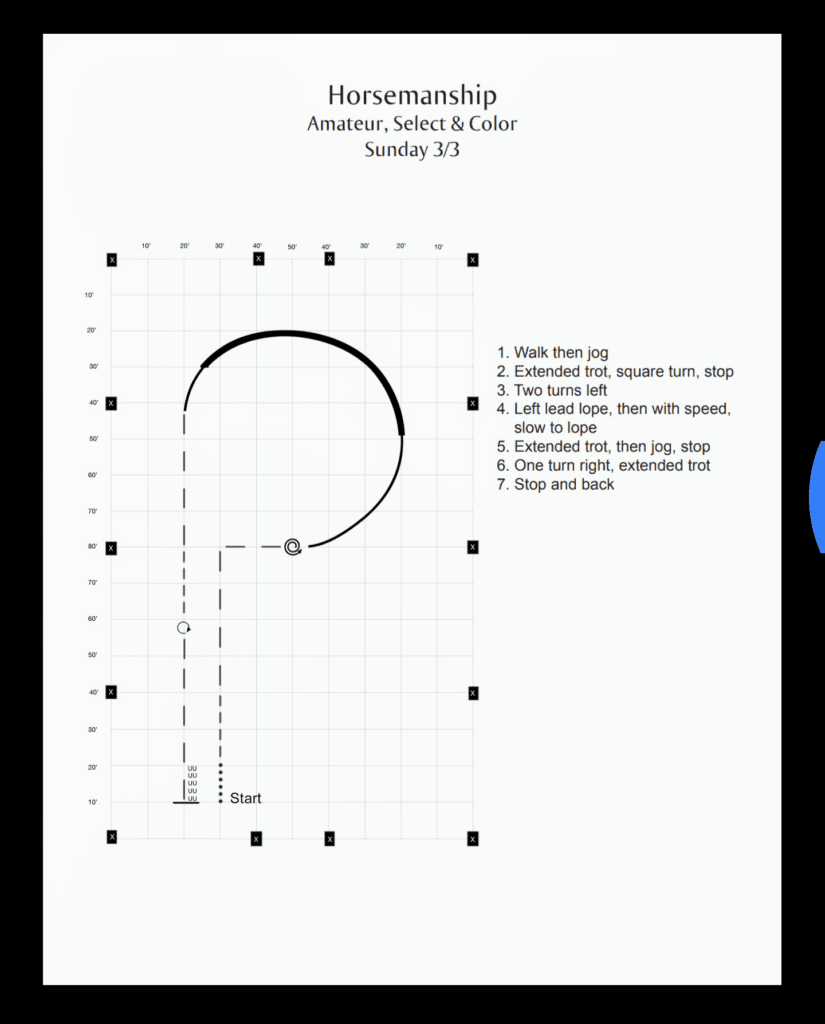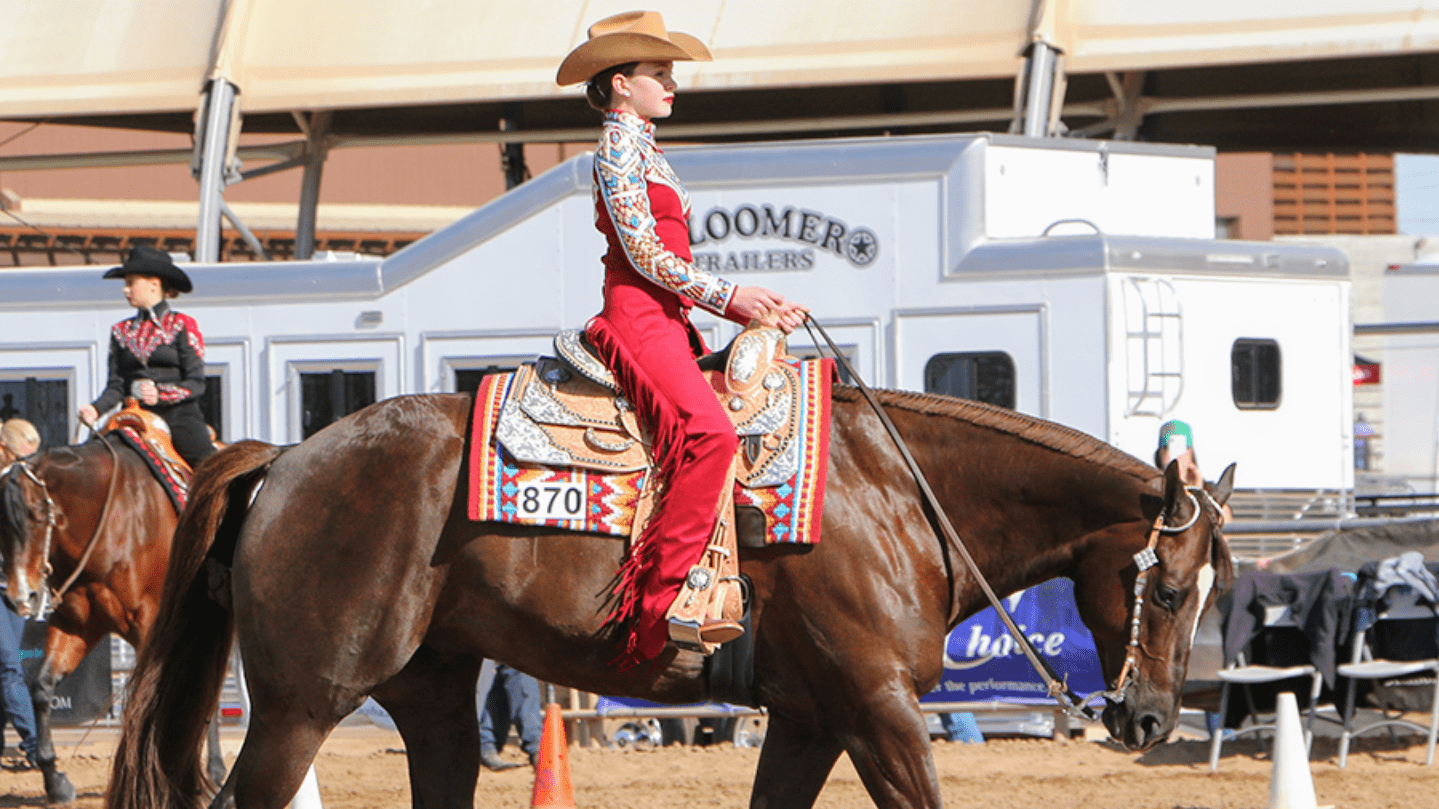The majority of individuals in the horse industry are accustomed to a standard pattern set up with markers being located in the middle of the arena. You typically begin with a cone beside or near the horse and continue to execute the maneuvers in the order of how the cones are labeled. This structure allows the riders to manipulate circles, lines, backs, etc. to fit their horse’s abilities.
For example, if a contestant is poor with manufacturing a large figure-eight due to the horse becoming strung-out, they could potentially make that action smaller to present a neater outcome. Doug Huls, show director of the Sun Circuit, has invented a new system that will prevent these exhibitors from avoiding the more difficult tasks in their classes. There are no more hiding weaknesses with the Grid System.
The Grid System is designed similar to a dressage course with markers spaced out on the outside rails. On average, there is a total of around fifteen cones. Every cone may not be implemented during the pattern but will still be present in the arena, which is arranged in 40’ intervals to match the instructions on the pattern.
 Exhibitors will be required to perform precise, neat lines to correctly complete the pattern as drawn. These markers are more of a structure than a point destination as most other standard patterns operate. If the paper shows a large circle from markers 4-6, the maneuver score will be deducted if the circle is not exactly ridden on those markers. Horsemanship, equitation, and showmanship are the three classes that used the grid style.
Exhibitors will be required to perform precise, neat lines to correctly complete the pattern as drawn. These markers are more of a structure than a point destination as most other standard patterns operate. If the paper shows a large circle from markers 4-6, the maneuver score will be deducted if the circle is not exactly ridden on those markers. Horsemanship, equitation, and showmanship are the three classes that used the grid style.
Sun Circuit Debuts Grid
As of today, the Sun Circuit is the only show organization to use this format. It was created for their National Championship on March 10th, 2018 along with continued use in other events such as bracket shows. When Huls invented the grid outline, there were many trial and error occurrences until it was perfected, as he explained. The only downfall to it is if there is limited warm-up space. A full arena is needed to practice the pattern as illustrated accurately. Although, patterns are released early to ensure enough time for individuals to rehearse at home.
One of the most beneficial aspects of the Grid System is that it challenges those top end exhibitors, pushing them to become the best through unfamiliar occasions. Huls created this outline to “Raise the degree of difficulty.” When practiced and represented with quality, it shows real skill and horsemanship.
“I loved the grid. I think it challenged everyone to ride the pattern as drawn. Each maneuver had to be in a specific spot, and there was little room for error,” says Amateur Carey Nowacek, who was at the Sun Circuit when this system debuted. “Most patterns we do these days have maybe one cone, and the rest is left for you to interpret, which makes it tough, because maybe the way you interpret the pattern, one judge sees it laid out differently. Using the grid, everyone lays the pattern out almost the same.”
With other patterns, these advanced riders can exaggerate their strongest points and hide the imperfections. This new design “Shuts down their options making them have to ride what is given to them.” For some, this tactic will be a tremendous challenge to overcome as it is different from their routine. Others will find the tricks to making the performance look outstanding. It will categorize those who practice harder for that win.
Amateur Lauren Stanley adds her thoughts, “As with any pattern, I found pros and cons with using a grid. I liked knowing exactly when, and for how long a maneuver was expected to be executed. It was truly an equal comparison of each horse and rider team by having that. It also required a higher degree of difficulty from us as riders to be able to hit all of our marks at the required time. If your downward departure wasn’t perfect, you couldn’t extend the rest of your pattern to make it appear as if it was intended. But if you nailed that mark, you showcased your connection with your horse. The hardest part of having the grid was refraining from showcasing my horse’s strong points. I love galloping him, so on patterns without a grid, I always make my gallop larger to make the most of it. With a grid, you can’t accentuate the good and blend in the weak as much. Overall, I think grid patterns force you to be a better rider and showman.”
Follows AQHA Rules
AQHA rules are used for the Sun Circuit and have no changes when it comes to the grid system. “Judges like how clear-cut the setup is,” Doug Huls stated. It is straightforward to see if a rider is not executing the pattern to full expectation. During the Sun Circuit National Championship, rail work was not included. The pattern showed enough difficulty to allow judges to easily separate exhibitors into groupings to be placed. Overall, the process was new and challenging for competitors and facile for judges to see and evaluate. Although strenuous, most riders performed the pattern well.
Because this new system is unique in its design and brings a fresh experience to shows, it would be beneficial for any association to adopt. Instead of the same patterns that exhibitors are expecting, the grid system keeps riders and spectators on their toes. There are many positive aspects of the style and it would be an excellent exercise for people to practice at home to advance their skills.
About Doug Huls
Huls originates from Iowa where he discovered his fascination with horses. His family was not involved in the horse industry, but he acquired enough money to purchase his first horse at the age of twelve. This began a long-lasting interest in these amazing creatures.
After attending college for two years at Iowa State, Huls continued his passion with horses by moving to Texas. There, he apprenticed at El Centro Ranch with Tom Chown and Steve Heckaman. This then led him to become an AQHA judge and create a prosperous training business in 1996.
The Sun Circuit then received his talent and experience in 2011 as head director. As a former exhibitor, Huls has an inside look to how the riders want the show to run. He is dedicated to making his shows run smoothly and keeping it entertaining for all level riders.
About the Author: Georgia Smith has always been intrigued by anything equine related since she was a little girl. Throughout the years, Georgia has been the national high individual in horse judging as well as placing top 10 at the All-American Quarter Horse Congress. She has been riding/showing horses for 14 years with her trainer, Charlene Carter, who has led her to take up jumping at Harmony Hill Farms. As Georgia is going to college to major in journalism, she is adamant about continuing her passion for horses through her writing.








